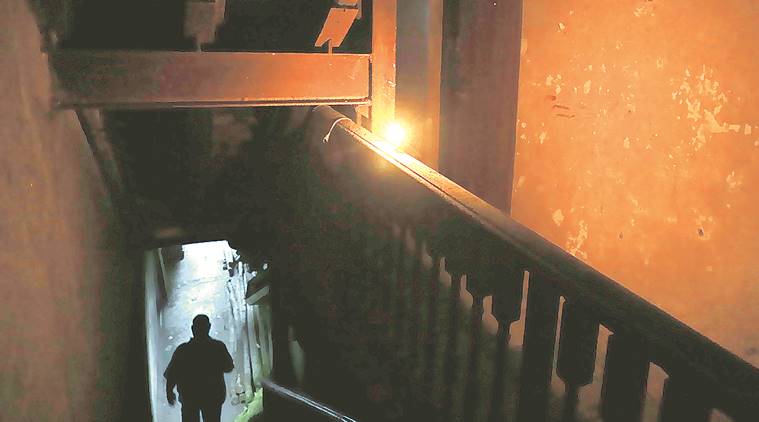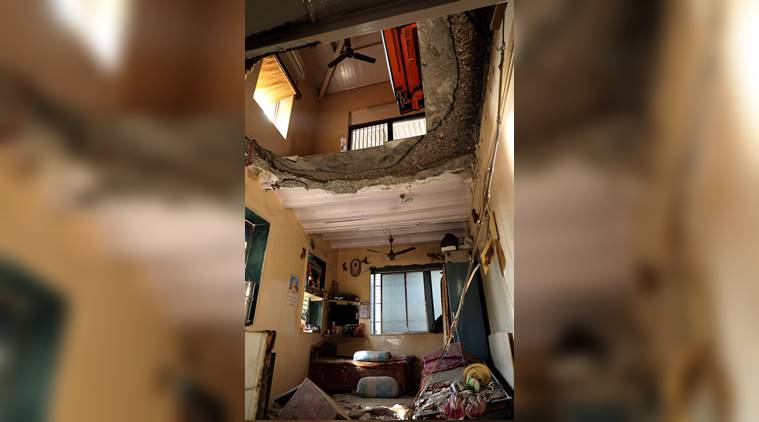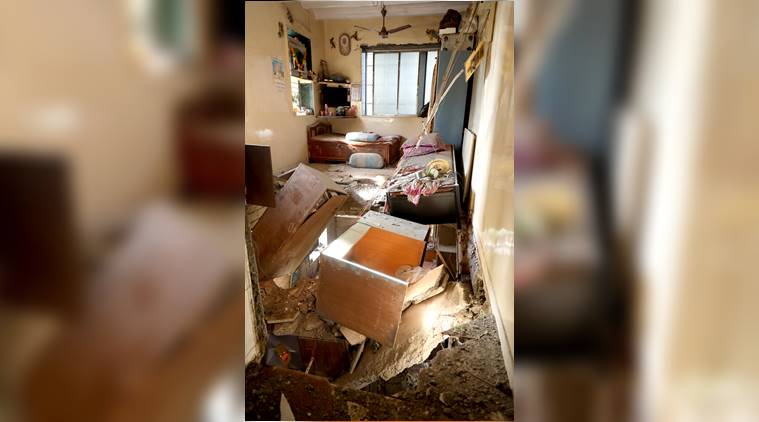Stay updated with the latest - Click here to follow us on Instagram
Mumbai: Residents get notice to vacate flats hours after building collapse
Recently, a building condition survey conducted by the Mumbai Metro Rail Corporation (MMRC) had described the building as falling in the “severe” category after surveying 32 flats.
 Power supply has still not been restored at Jer Mahal annexe building. (Express photo by Nirmal Harindran)
Power supply has still not been restored at Jer Mahal annexe building. (Express photo by Nirmal Harindran)
HOURS AFTER the third floor of a three-storey building collapsed at Dhobi Talao in Mumbai last Saturday, the residents were served with a notice by the Maharashtra Housing and Area Development Authority (MHADA), asking them to vacate their houses as it was a safety concern. Power supply to the building was also disconnected.
While several residents of the annexe building to the Jer Mahal shifted to hotels or to their relatives’ homes, many continue to live in the building. Peter Pinto (63) is one of them.
While Pinto had initially shifted to a hotel, he could not afford it and returned home. “The MHADA asked us to vacate our homes but we have nowhere to go. It only sent us a notice to vacate but nobody came to speak to us or help us. We are now managing without electricity,” said Pinto.
Recently, a building condition survey conducted by the Mumbai Metro Rail Corporation (MMRC) had described the building as falling in the “severe” category after surveying 32 flats. On the day of the survey, 16 other flats were found locked. On April 11, the MMRC put up notices on the doors of these 16 flats seeking permission to conduct the survey. Only one family responded and a survey was scheduled to be held in the flat on April 22. On April 21, the building collapsed, injuring a woman.
 The Jer Mahal Annexe building in Kalbadevi that caved in and collapsed on Saturday. (Express photo by Nirmal Harindran)
The Jer Mahal Annexe building in Kalbadevi that caved in and collapsed on Saturday. (Express photo by Nirmal Harindran)
“During the survey, a few residents were not available. However, we will issue a public notice to inform non-resident occupants to make their premises available for survey,” said an MMRC spokesperson.
MMRC — which is working on Metro 3 construction in the area — is working on propping support structures for several buildings in the area, including those in the Jer Mahal estate, which include iconic places like Kyani & Co and Furtados, among others.
A member of the contractor’s team said: “We stopped tunnelling activity on April 18 after reaching the Metro Cinema junction to complete propping activity of the buildings. We generally complete propping of a certain stretch and then take up tunnelling.”
 While MMRC has maintained it was not in any way responsible, claiming that its tunnel boring machines were at least 120 m away from the building, residents said they felt vibrations and had called the MMRC staff to complain a day before the collapse. (Express photo by Nirmal Harindran)
While MMRC has maintained it was not in any way responsible, claiming that its tunnel boring machines were at least 120 m away from the building, residents said they felt vibrations and had called the MMRC staff to complain a day before the collapse. (Express photo by Nirmal Harindran)
On the collapse, he said: “We had installed a building settlement marker on the building and were monitoring it. But since it was installed on the external wall, the collapse of the slab inside could not be predicted.”
While MMRC has maintained it was not in any way responsible, claiming that its tunnel boring machines were at least 120 m away from the building, residents said they felt vibrations and had called the MMRC staff to complain a day before the collapse. However, there was no response to the complaint.
“Though old and weak, our building was surviving. It is only after the Metro work began, something like this happened. They had visited us a few days ago to say that case of any risk, they will shift us to some hotel but now nobody has come to our rescue. Neither MHADA has arranged for any alternative accommodation nor is MMRC coming forward,” said a resident of the building.
The MMRC spokesperson said the question of shifting people will arise only when even after following all safety protocols, it is difficult to maintain the building. “In this case, what happened has nothing to do with Metro construction activity. Therefore, there is no question of shifting the occupants.”
“The severe condition of old and dilapidated buildings in Mumbai and their redevelopment is an independent issue… Attributing this problem merely to Metro construction without understanding the safety protocol may not be appropriate,” he added. Despite repeated attempts, MHADA officials could not be contacted for a comment.







